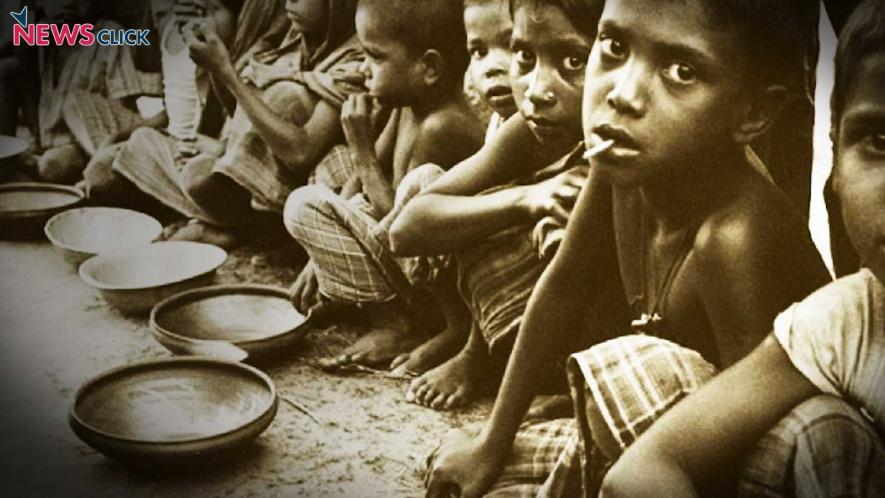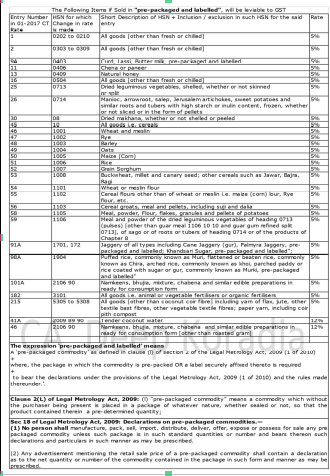A Super-Tax on Nutrition in Malnourished India?

Get ready to pay GST on your jhalmuri and bhujiya because amid rising fuel prices, global food inflation and imminent nutrition crisis, the GST Council has taxed most of India’s ‘desi’ food products. Millet, rice, cottage cheese, savouries, lotus seed and jaggery, as per the government’s notification, will have to pay GST for purchases below 25 kilos. The GST, at varying rates, will apply to “pre-packaged” and “labelled” products in the market. The target is ultimately the small buyer of these items, as purchases of over 25 kilos are not in the ambit of the recent notification.
Before we move further, it is vital to understand the term “pre-packaged”. It means “a commodity which, without the purchaser being present, is placed in a package of whatever nature, whether sealed or not, so that the product contained therein has a pre-determined quantity”. So, any quantity of these items weighing below 25 kilos has been brought under the GST net, and even hawkers, street vendors and local grocery/kirana stores will be bound to comply. The GST Council has not even spared local Indian food items such as puffed rice, khoi, and salted snacks.
In a queer way, the GST Council has built upon Prime Minister Narendra Modi’s vision of “pakoda-nomics”. After all, unemployment is a myth. Right? To paraphrase his remarks, if someone opens a pakoda shop before your office, does that not count as employment? A person’s daily earning of Rs. 200 will never come into any books or accounts. The truth is massive people are being employed, Modi had said. And so, the government has decided to tax the pakodawala and every street food vendor through the new notification. It is a clear-cut attempt to formalise the unorganised food sector by discouraging the smallest vendors through a tax burden.
But that is not all. Contrary to its claims of seeking to promote organic farming, the government has even decided to impose GST on organic fertilisers and organic food items. This will directly affect small-scale organic farmers who trade in organic fertilisers or make it. They all need to charge GST on the fertilisers and their produce. This tax raises the cost of organic food and eats into the profits of small and middle organic farmers and traders.
Another food-related tax in the new list covers items sold in tetra-packs. On them, a whopping 18% rate has been imposed. Imagine customers who buy milk in tetra-packs or infant food. They will pay 5% more tax on the milk (also included in the new GST list) and an additional 18% tax on the tetra-packs. The move will push premium foods away from middle-class and wealthy families’ household budgets. But it is not just these categories who are affected.

Soon after the government announced the tax, Amul, which mass produces milk and milk products across India, hiked the prices of curd and curd-based products. According to news reports, a 200 gm cup of curd now costs Rs. 21 instead of Rs. 20 at Amul, while curd will cost Rs. 2 more. Curd products sold in tetra-packs have seen bigger price hikes. Other manufacturers are likely to raise prices. Meanwhile, farmers and farm organisations have already said the tax on dairy items will be a “death warrant” for them. Further, those engaged in agricultural trades are up in arms across the country, for example, rice millers in Karnataka, who are opposing the 5% tax imposed by the Centre on unbranded labelled rice.
Does malnourished India need to tax nutrition?
What makes the situation grimmer is India’s hunger and malnutrition ratings. The Global Hunger Index ranks India 101st out of 116 countries [it was 94th among 107 countries two years ago and India has close to 18 lakh severely malnourished children, while double the number, 33 lakh, are malnourished in total]. Cereal, millet and milk-based products like cottage cheese are the primary nutrition source for most Indians. Taxing the locally produced and packaged foods will raise household budgets, and per-person nutrition will likely fall.
Even before the Ukraine-Russia conflict, the food economy has been trundling towards inflation. Shortage of food grains and chemical fertilisers failed harvests in Punjab, and the global edible oil crisis had not just pushed Indians but the world towards a more serious malnutrition crisis. Recently, countries met at the United Nations to highlight imminent food security challenges.
Despite the regular ups and downs of the food inflation, there is no doubt Indians have been paying more for food since 2020. And, inflation has been above the so-called ‘comfort level’ of the government and RBI for six months until June. So, our plats are getting smaller and less nutritious. The new taxes will profoundly affect the nutrition available in the low and middle-income groups, as with every Rs. 100 spent on food, people will have to pay a minimum of Rs. 5 to the taxman.
Due to this new nutrition tax, the government’s revenue will grow as millions of people, and billions of transactions now fall under the GST ambit. It is sobering to realise that it comes at the risk of bolstering malnutrition in the country.
Winners and Losers of nutrition tax
Besides India’s nutrition ratings, small traders, women’s groups, Self Help Groups, street food vendors and local low-margin food businesses may be the worst sufferers. Just like they were during the demonetisation of November 2016. Of late, these segments of the economy have been attacked in two other ways. First, the government reined most food vendors using the FSSAI’s industrialised notions of “food-safety” laws. Under the same food laws, Gandhi’s Ghani, a traditional oil press in Wardha, Maharashtra, was issued a closure notice in 2015-16. Many such ventures were put out of business for failing to comply with the so-called sanitary, but often pseudo-sanitary, requirements imposed by the FSSAI. Here comes the second attack with the GST for those who managed to survive.
Practically speaking, it would take many vendors years to comply with the complex GST filing system and issue customer bills. The cost of printing bill books may be higher than the cost price of the snack or meal they are selling. Many vendors and traders are not literate and live in remote areas and will not be able to navigate the GST system fully. They face a dilemma, either comply—which is very tough—or become GST defaulters within the strict purview of the GST laws. The question of the state’s capacity to pursue such transactions and defaults is another matter altogether.
Where else have we seen similar strategies to goad small businesses out of work? There are many examples, the most prominent emerge in the United States, where corporate food processors and Big Ag wanted to finish off small farmers and food vendors so that corporate restaurant chains and super stores could capture the market.
Today, a handful of superstores dominate the US food market. And even as the food tax regimes grow, large traders and processors will be its biggest beneficiaries. The cost of compliance with new taxes or industrial food safety regulations is much easier for corporations as they are designed keeping compliances in mind. Not so for the jhalmuri seller. By introducing this new tax on nutrition, the GST council has tilted the food system in favour of big companies, sacrificing the small vendor and the indigenous food economy.
The author is an independent analyst and writer. The views are personal.
Get the latest reports & analysis with people's perspective on Protests, movements & deep analytical videos, discussions of the current affairs in your Telegram app. Subscribe to NewsClick's Telegram channel & get Real-Time updates on stories, as they get published on our website.






















